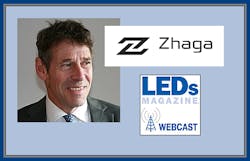This week, Zhaga Consortium secretary general Dee Denteneer presented a webcast that covered the industry professional organization’s current Books that have been launched to standardize interfaces for solid-state lighting (SSL) design components. He also explained how the circular economy concept, involving serviceable luminaires, could be served by this standardization and how these topics tie in to the role of lighting in the Internet of Things (IoT) as companies across the supply chain attempt to redirect their businesses to counteract the commoditization of SSL.
You can access the entire on-demand presentation and get all the pertinent information that Denteneer shared with the audience. But I thought I would pull out a few of the most interesting points from the webcast, which speak volumes about the needs of the SSL industry and where Zhaga sees there is plenty more work to be done.
A fast-growing installed base of connectable, future-proof luminaires will host a large ecosystem of sensors and connectivity modules, securing a central place for lighting in the IoT.
While predictive, Denteneer’s statement on the slide presentation is, I think, spot on with other observers and leaders in the industry. Take, for example, the lighting trends our partners at Lux had published in December, looking ahead to 2018. Luminaire functionality and the expansion of the connected office were two concepts they predicated would become more prominent this year, although I think many would agree that the connected, intelligent feature set will continue to be a driver of product development for quite some time beyond 2018.
There are many unknowns in the smart-city application. There are multiple protocols and technologies in play, and luminaires are being installed that need to be there for 20-30 years.
City engineers, lighting specifiers, and planning officials do not need to panic that they will only end up trapped into purchasing obsolete technology if more manufacturers recognize the benefits of designing their products with interoperable components. This requires the right interface to be able to upgrade your luminaire, said Denteneer. We are talking specifically about serviceability, but there are two key factors at play. You can address maintenance when components need to be changed out due to failure and/or end of life, yes, but you can also achieve the flexibility to upgrade the lighting technology in the field when component interfaces are standardized. Generation 1 components can be swapped out for Gen 2, for example, and forward.
Serviceability and interoperability leads to a circular economy model that can be very beneficial to the SSL industry.
LightingEurope, an organization that represents European lighting manufacturers, national lighting associations, and other parties in policy-making and industry roadmapping, had previously released a white paper exploring how the SSL industry could benefit from delivering serviceable luminaires and leverage the so-called circular economy. LightingEurope has indicated that this model will create more service opportunities as there will be a need for refurbishment and parts recycling that doesn’t routinely occur now. During the webcast, Denteneer explained that the serviceable luminaire concept would mean less waste and more opportunity for customization. Manufacturers could accommodate changes in performance, aesthetics, functionality, building layout or utilization, and even technology advances, enabled by the standardization of interfaces.






